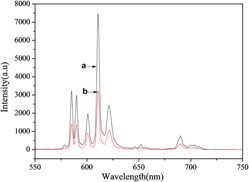Article contents
Enhanced photoluminescence property of co-doped ZnB2O4: Eu3+, Tb3+ phosphor prepared by a thermal conversion method
Published online by Cambridge University Press: 13 January 2016
Abstract

The co-doped ZnB2O4:Eu3+, Tb3+ phosphor was prepared by a thermal conversion method using Zn[B3O3(OH)5]·H2O:Eu3+, Tb3+ as the precursor, which was characterized by energy dispersive x-ray spectrometer, x-ray powder diffraction, infrared, scanning electron microscopy, and photoluminescence. The effects of doped concentration, calcining temperature, and calcining time of precursor on the luminescence property of ZnB2O4: Eu3+, Tb3+ phosphor were investigated. The results showed that the ZnB2O4: Eu3+, Tb3+ phosphor with maximum luminescent intensity was obtained by calcining the precursor at 900 °C for 6 h. It is found that the ZnB2O4: Eu3+, Tb3+ phosphor prepared by this method exhibits much stronger emission intensity than that synthesized by conventional high temperature solid-state method. Meanwhile, ZnB2O4: Eu3+, Tb3+ also has stronger emission intensity and higher red to orange ratio than those of ZnB2O4: Eu3+.
Keywords
- Type
- Articles
- Information
- Copyright
- Copyright © Materials Research Society 2016
References
REFERENCES
- 6
- Cited by


